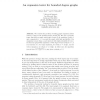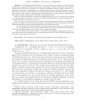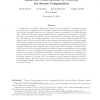124
click to vote
SIAMCOMP
2011
14 years 3 months ago
2011
The Gibbard-Satterthwaite theorem states that every non-dictatorial election rule among at least three alternatives can be strategically manipulated. We prove a quantitative versi...
148
Voted
SIAMCOMP
2011
14 years 3 months ago
2011
We consider the problem of testing graph expansion (either vertex or edge) in the bounded degree model [10]. We give a property tester that given a graph with degree bound d, an ex...
191
Voted
SIAMCOMP
2011
14 years 3 months ago
2011
We consider the Minimum Linear Arrangement problem and the (Uniform) Sparsest Cut problem. So far, these two notorious NP-hard graph problems have resisted all attempts to prove in...
115
Voted
SIAMCOMP
2011
14 years 8 months ago
2011
Reingold, Vadhan and Wigderson [21] introduced the graph zig-zag product. This product combines a large graph and a small graph into one graph, such that the resulting graph inher...
132
click to vote
SIAMCOMP
2011
14 years 8 months ago
2011
We investigate ways in which an algorithm can improve its expected performance by fine-tuning itself automatically with respect to an arbitrary, unknown input distribution. We gi...
143
Voted
SIAMCOMP
2011
14 years 8 months ago
2011
Abstract. In the 2nd Annual FOCS (1961), Chao-Kong Chow proved that every Boolean threshold function is uniquely determined by its degree-0 and degree-1 Fourier coefficients. These...
127
Voted
SIAMCOMP
2011
14 years 8 months ago
2011
In this paper, we study the question of whether or not it is possible to construct protocols for general secure computation in the setting of malicious adversaries and no honest m...
132
click to vote
SIAMCOMP
2011
14 years 8 months ago
2011
Set agreement, where processors decisions constitute a set of outputs, is notoriously harder to analyze than consensus where the decisions are restricted to a single output. This ...



